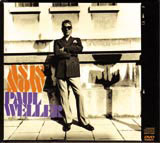Profile: Simon Halfon

Simon Halfon has been living a dream, designing album sleeves for a host of rock and pop stars, and managing the image of Paul Weller. But success has not turned his head, says Richard Clayton
For many designers, it would be a dream gig. Yet, when a famous rock star trusts you to manage his image, to what lengths should you go? ‘I don’t wake up in the morning and dress him,’ laughs Simon Halfon (pictured), who has kept Paul Weller on-side for 23 years. But you’re effectively his personal creative director? ‘I guess,’ he replies, warily. ‘Although it sounds pompous to say that out loud.’
Next month, Weller receives a lifetime achievement gong at the 2006 Brit Awards. Halfon has been preparing artwork for a solo greatest hits release, though that’s just been postponed to promote the current album, As Is Now, Weller’s best record in a while. Another ‘calling card’ client, Oasis, are also doing rather well. A third single from their number one album, Don’t Believe the Truth, was in the top three before Christmas, with posters and sleeve designs – including the hand-painted guitar for The Importance of Being Idle – all by Halfon. ‘You look back on things as a campaign, but, at the time, so much is done by the seat of your pants,’ he reflects. ‘I actually prefer that, because if it’s too regimented, it’s dull.’
Affable and unassuming, Halfon is more the old-fashioned ad man than the kind of designer to fret over fonts. With no formal training, there’s a winning amateurism about him. In the mid-1980s, he even directed a TV commercial for The Style Council. ‘It was basically the two of them, walking away from the camera towards a coat stand,’ he remembers. ‘We got Rupert Everett to do the voice-over because Another Country had just come out, and then we took off Carlsberg with our tagline, “The Style Council, probably the best pop group in the world”.’
A chance meeting with the Clash’s factotum, Kosmo Vinyl, had given Halfon a start in the music business at Stiff Records. He progressed from the post room, via radio-plugging, to the art department and Neville Brody – ‘well known in the design world, I’m told’, he winks. By the time Halfon left, Brody had joined The Face, but offered him a job helping with non-magazine projects.
‘I knew nothing, other than just looking at record sleeves and knowing what I liked,’ Halfon recalls. ‘Brody gave me an understanding of how typography works, by watching how he did things. I borrowed his technique – and Helvetica Bold Extended – which I still use to this day!’

Halfon sketches his own early freelancing as happy-go-lucky – strolling through Soho, whistling for his work, as friendly, neighbourhood record companies put their heads round doors to shout, ‘Hey, wanna design a Level 42 single?’ Commissions followed for Kim Wilde, Madness and Nick Heyward. In 1990, Halfon moved to Los Angeles and scaled the heights with George Michael. ‘Something I still stand by, and take pleasure in, is that Listen Without Prejudice cover,’ he says. ‘It’s just a great image, with no type on it. So many people ask me, “How did you get all those people to face the camera?”, but it was an existing photograph, by Weegee, of Coney Island. Today, it would be virtually impossible to get the rights cleared, but we paid $500 [£282] for it.’
Returning to Blighty, he persuaded Peter Blake to co-design Stanley Road (Weller’s 1995 album), and hooked up with Oasis in 1999. Fittingly, given Britpop’s 1960s fetish, it’s Pop Art that gets Halfon’s mojo working.
‘The White Album, designed by Richard Hamilton, is the quintessential album for me,’ he says. ‘Hamilton was so involved, even down to it just being called The Beatles, with their name embossed. I think the only thing he wanted to add was a coffee ring. The top opening and black inner sleeves, the poster insert and individual portraits – that’s the ultimate package. It’s the sparsity of the outer sleeve, along with that fantastic collage work, which I’ve aspired to copy many times over.’
And Halfon’s verdict on his own output? ‘You don’t succeed every time, but every now and again you might get one in the back of the net,’ he says, simply. That’s the sort of directness of which the Modfather no doubt approves.
-
Post a comment



